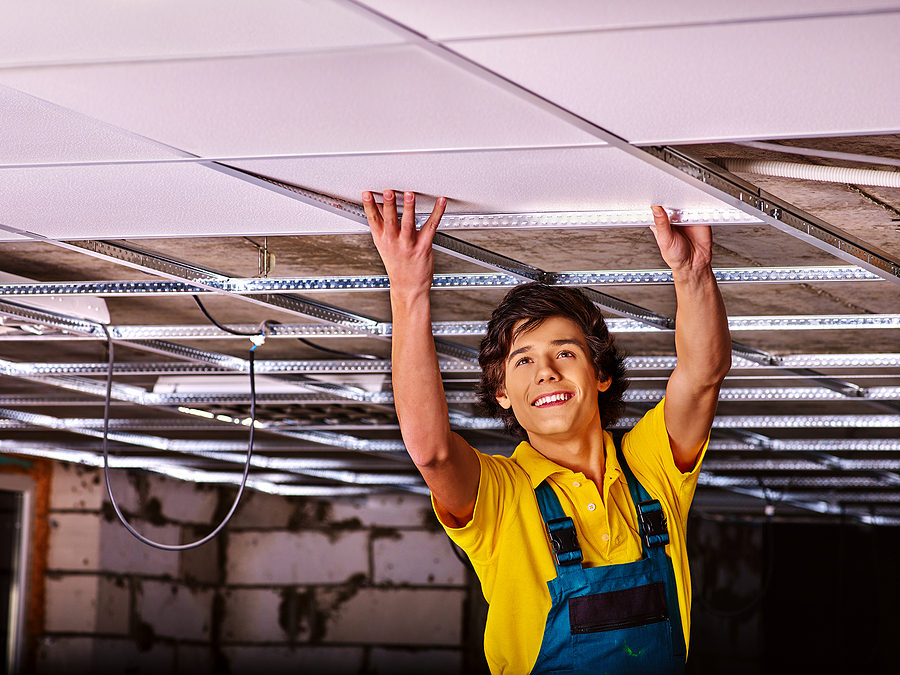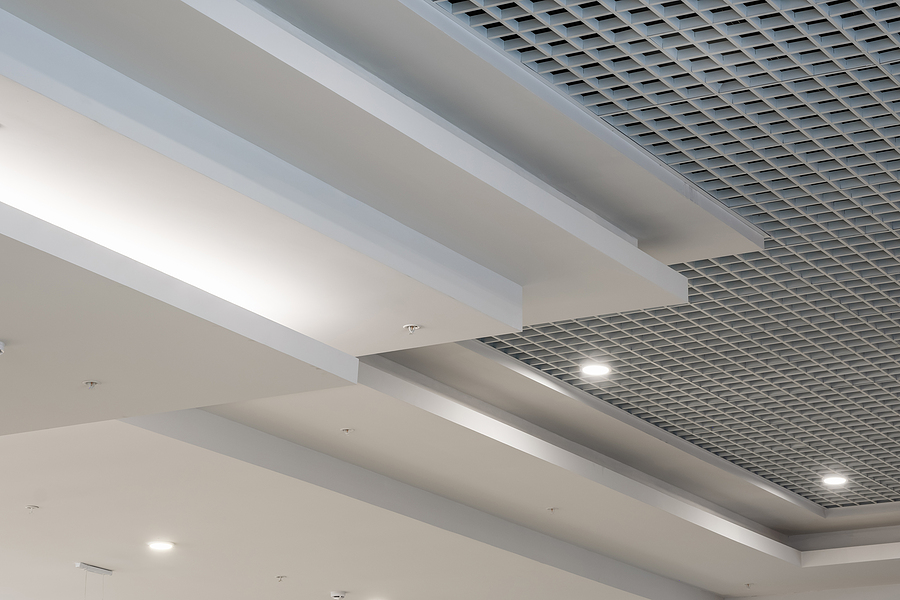Suspended ceilings, often found in offices, commercial spaces, and homes, are popular for their sleek appearance, soundproofing capabilities, and easy access to overhead systems like plumbing and HVAC. However, they’re not immune to wear and tear. From sagging tiles to water damage, suspended ceilings can develop issues over time, compromising their functionality and aesthetics.
If you’re a building manager, business owner, or homeowner dealing with ceiling issues, this guide is here to help. We’ll walk you through everything from identifying common problems to performing repairs and preventing future damage. Whether you’re planning a DIY fix or considering hiring a professional, this comprehensive guide will lead you in the right direction.

What is a Suspended Ceiling?
A suspended ceiling, also known as a dropped ceiling or false ceiling, is a secondary ceiling that hangs below the main structural ceiling. This space, known as the plenum, is often used to conceal electrical wiring, plumbing, and HVAC systems. Suspended ceilings consist of a metal grid framework that holds lightweight tiles, often made of materials like gypsum, fiberglass, or mineral fiber.
Suspended ceilings are favored for their versatility, ease of installation, and acoustic benefits. However, like any structural feature, they require periodic maintenance and repairs to remain functional and safe.
Common Issues with Suspended Ceilings
Before jumping into repairs, it’s crucial to identify the problem. Here are some common issues you might encounter:
1. Water Damage
Caused by leaks from pipes or roofs, water damage usually presents as stained, swollen, or discolored tiles. Left unchecked, it can lead to mold growth and compromise the structural integrity of the ceiling.
2. Sagging
Sagging occurs when the grid or tiles droop due to excessive weight, moisture, or aging materials. This not only looks unsightly but can also pose safety risks.
3. Cracked or Broken Tiles
Tiles can crack or break due to impact or wear. Damaged tiles can affect the aesthetics and reduce the ceiling’s functional efficiency, such as dampening sound.
4. Loose Tiles
Tiles that don’t fit snugly into the grid can shift or fall, often as a result of poor installation or vibrations from HVAC systems.
5. Structural Issues
Over time, the metal grid holding the tiles can corrode, bend, or loosen, compromising the entire ceiling framework.
Learn More About Drywall Ceiling Repairs
Why Professional Repairs Are Important
While DIY repairs can address some minor issues, hiring a professional drywall and ceiling repair company like Drywall by Renso offers several advantages:
- Safety: Professionals have the expertise and equipment to address ceiling damages safely, preventing potential injuries.
- Expertise: Complex issues, such as recurring leaks or sagging, often require an expert diagnosis and repair.
- Long-Term Results: A properly repaired ceiling lasts longer and reduces the likelihood of future issues.
- Compliance: For commercial spaces, professional contractors ensure repairs meet local codes and regulations.
Tools and Materials Needed to Repair a Suspended Ceiling
If you’re wondering how your professional drywall team will tackle suspended ceiling repairs, here’s a list of the expected tools and materials used for the job:
- Safety gear (gloves, goggles, mask)
- Step ladder or scaffolding
- Replacement tiles
- Metal grid parts (if needed)
- Utility knife
- Measuring tape
- Screwdriver or drill
- Sandpaper
- Paint (for touching up)
Step-by-Step Suspended Ceiling Repair Guide
Here’s a brief explanation of what you can expect from the suspended ceiling repair process:
Step 1. Damage Assessment
They will inspect your suspended ceiling for visible issues like stains, sagging, or cracks. They will also check the plenum for underlying causes, such as leaks or broken grid components.
Step 2. Preparing the Workspace
They will then clear the area beneath the damaged section to avoid accidents. They will also lay down a drop cloth to catch debris and work safely with safety gear.
Step 3. Damaged Tile Removal
Next, they will carefully remove damaged tiles by lifting them out of the grid. For stains, they might consider cleaning the tile with a mild solution before deciding to replace it.
Step 4. Grid and Framework Repairs
At this point, they will inspect the metal grid for damage. Then they might tighten any loose connectors and replace bent or corroded sections with new ones.
Step 5. Replacement Tile Installation
Now, they will cut replacement tiles to size (if necessary) using a utility knife. From there, they will insert them into the grid, ensuring they are secured and aligned.
Step 6. Final Checks
Drywallers will finish by ensuring the ceiling is level and all tiles fit snugly. They will also clean up the workspace and dispose of debris responsibly.
Prevention and Maintenance Tips for Suspended Ceilings
To avoid frequent repairs, adopt these simple practices:
- Conduct regular inspections for water leaks, tile displacement, or visible damage.
- Ensure proper ventilation to reduce moisture buildup, especially in humid environments.
- Use water-resistant tiles to minimize damage from accidental leaks.
- Promptly address roof and plumbing issues to prevent water damage.
- Avoid overloading ceilings with decorative items or excess weight.
- Schedule professional maintenance checks at least once a year.
Frequently Asked Questions About Ceiling Repair
How do I identify water damage on my suspended ceiling?
Look for signs like brown stains, warping, or mold growth on the tiles.
Can I replace ceiling tiles myself, or do I need a professional?
Minor tile replacements can be done as a DIY project. However, for extensive damages or structural issues, hiring a professional is recommended.
How often should I inspect my suspended ceiling for damage?
Inspect your ceiling at least twice a year or immediately after events like storms or leaks.
What are the costs associated with professional suspended ceiling repair?
Costs vary based on the extent of damage, materials, and labor. Request a free quote from Drywall by Renso to get an accurate estimate.
What causes sagging in suspended ceilings and how can it be prevented?
Sagging is usually caused by excessive weight or moisture. Prevent it by using lightweight tiles and addressing leaks or high humidity promptly.
RECAP
Suspended ceilings are a practical and stylish solution for modern spaces, but they require timely maintenance to stay in top condition. Whether you’re dealing with tile damage or structural issues, acting promptly can save you from costly repairs down the line.
For business owners, building managers, or homeowners in the Greater Indianapolis area, Drywall By Renso is here to help. Our licensed technicians specialize in professional drywall ceiling repairs to keep your spaces safe and stylish. Get started today by requesting a free quote.
Related Post: What You Need to Know About Having Grid Ceilings Installed

